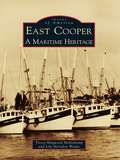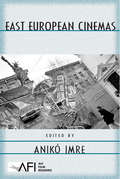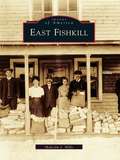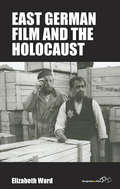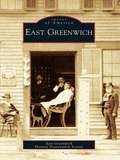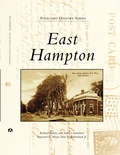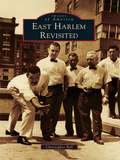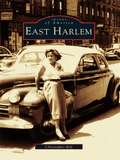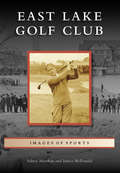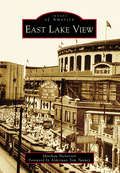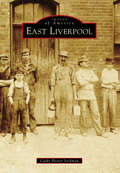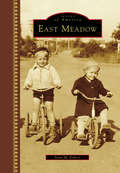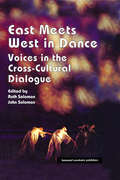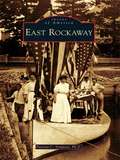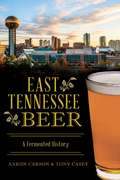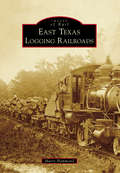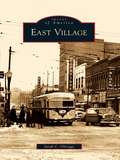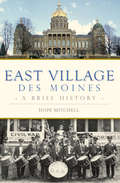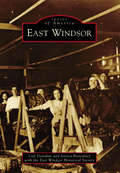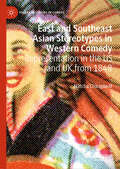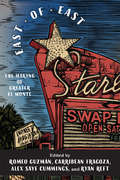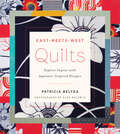- Table View
- List View
East Cooper: A Maritime Heritage
by Tressy Magwood Mellichamp Lily Herndon WeaksThe stretch of land known as "East of the Cooper," featuring the charming town of Mount Pleasant, is interwoven with innumerable waterways; these waters pulsate with the ebb and flow of tides like a network of arteries, veins, and capillaries connecting to the living heart that is the sea. Mount Pleasant's location on the Charleston harbor and its deep water access has ensured that the sea has played a major role in the lives of its residents, providing thriving maritime industries that are at once historic and contemporary. East Cooper: A Maritime Heritage is a celebration of those industries and the families and vessels that have contributed to this vital part of Lowcountry culture. Throughout history, indigenous peoples, colonists, plantation owners, and seafood industry entrepreneurs have traversed the miles of rivers, marshy creeks, and coastlines of the East Cooper area. This collection of images demonstrates the ingenuity and artistry of these people whose descendants shared their pasts with the authors as generously as their ancestors shared their skills and intimate relationships with the local waters.
East European Cinemas (AFI Film Readers)
by Anikó ImreFirst Published in 2005. Routledge is an imprint of Taylor & Francis, an informa company.
East Fishkill (Images of America)
by Malcolm J. MillsIn Revolutionary days, East Fishkill was on the route of an important highway from Boston to the Hudson River, traveled by Gen. George Washington, Gen. John Burgoyne, and John Jay. The town separated from Fishkill in 1849 and received its own charter. East Fishkill remained a mainlyagricultural community until 1960, when IBM opened achip-manufacturing plant in town. Then it changed dramatically: the farmland disappeared under housing and commercial development. East Fishkill offers a fascinating glimpse of life in the town while it was still rural.
East German Film and the Holocaust (Film Europa #22)
by Elizabeth WardEast Germany’s ruling party never officially acknowledged responsibility for the crimes committed in Germany’s name during the Third Reich. Instead, it cast communists as both victims of and victors over National Socialist oppression while marginalizing discussions of Jewish suffering. Yet for the 1977 Academy Awards, the Ministry of Culture submitted Jakob der Lügner – a film focused exclusively on Jewish victimhood that would become the only East German film to ever be officially nominated. By combining close analyses of key films with extensive archival research, this book explores how GDR filmmakers depicted Jews and the Holocaust in a country where memories of Nazi persecution were highly prescribed, tightly controlled and invariably political.
East German Film and the Holocaust (Film Europa #22)
by Elizabeth WardEast Germany’s ruling party never officially acknowledged responsibility for the crimes committed in Germany’s name during the Third Reich. Instead, it cast communists as both victims of and victors over National Socialist oppression while marginalizing discussions of Jewish suffering. Yet for the 1977 Academy Awards, the Ministry of Culture submitted Jakob der Lügner – a film focused exclusively on Jewish victimhood that would become the only East German film to ever be officially nominated. By combining close analyses of key films with extensive archival research, this book explores how GDR filmmakers depicted Jews and the Holocaust in a country where memories of Nazi persecution were highly prescribed, tightly controlled and invariably political.
East Greenwich
by East Greenwich Historic Preservation SocietyEast Greenwich, the eighth-oldest town in the state, was named for the original Greenwich in Kent County, England. The eastern edge rests on the Narragansett Bay, and the western land gracefully rises up four picturesque hills. Originally owned by the Narragansett Indians, the territory was acquired by King Charles II in 1644. It was incorporated as a town on October 13, 1677, when the Rhode Island General Assembly granted land to men who served during King Philip's War. The town's sheltered cove nurtured a thriving seaport community, and successful boatbuilding, rope making, and fishing industries emerged. Inhabitants of the western part of the village focused on farming, and a prosperous textile industry lasted until the end of World War II.
East Hampton (Postcard History)
by Richard Barons Mayor Paul Rickenbach Jr. Isabel CarmichaelEast Hampton began as a fishing and farming community in the 1600s, but by the late 18th century, the area had grown to be a popular summer destination. Within a year of its construction in 1796, the Montauk Lighthouse was already attracting tourists. By the mid-19th century, steamships and railroads were taking visitors to see the magnificent beaches and stay in the boardinghouses. The smaller East Hampton communities, such as Montauk, Amagansett, and Wainscott, also became favored locations for people escaping the heat of the cities, and they remain highly sought-after destinations today.
East Harlem Revisited
by Christopher BellEast Harlem Revisited presents a fresh look at this historic neighborhood through rare photographic images. Photographs taken from tenement rooftops, at family gatherings, and of sports and events celebrate a bygone era and the neighborhood's diversity. A neighborhood of many ethnicities and languages, at one time a section of East Harlem made up the largest Little Italy in the country. The landmarks that have been preserved throughout the years detail the importance and impact of architectural development on East Harlem's history. Photographs of the neighborhood's tenements and public housing depict East Harlem's changing landscape, while images of famous residents celebrate the many talented individuals who have called East Harlem home.
East Harlem: Oral Histories Of Community And Diversity (Images of America)
by Christopher BellOvershadowed by the fame of Harlem and the wealth of the Upper East Side, East Harlem is rarely noted as a historical enclave. However, from the early 1800s through today, East Harlem has welcomed wave after wave of immigrants struggling for a place in the nation's most famous city. African Americans, Irish, Germans, European Jews, Italians, Scandinavians, Puerto Ricans, and Latinos are among the ethnic groups who have shaped this neighborhood, bringing with them their religious, social, and culinary traditions. East Harlem is the first volume to tell this neighborhood's history through images. Photographs of the iron, stone, and rubber factories, the tenements, the 100th Street community, famous politicians such as Fiorella LaGuardia, the Second and Third Avenue elevated subways, St. Cecilia's, and many other subjects capture East Harlem's past in one memorable collection.
East Lake Golf Club (Images of Sports)
by Janice Mcdonald Sidney MatthewEast Lake Golf Club was heralded as "one of the finest in the United States" when its first holes were completed in 1907. Bobby Jones called East Lake his home course, as did Alexa Stirling, Watts Gunn, and Charlie Yates. It flourished in the early 1900s as the Atlanta Athletic Club's country club. However, as Atlanta's population shifted to the northern suburbs, East Lake suffered, and in the mid-1960s the AAC sold the property and moved to Johns Creek. In the 1990s, developer Tom Cousins stepped in to restore East Lake. Today, the historical East Lake Golf Club is again considered among the finest courses in the United States and is host to tournament play. The motto adopted at its rebirth rings true: "Golf with a Purpose."
East Lake View (Images of America)
by Foreword By Tunney Matthew NickersonEast Lake View is one of Chicago’s most popular neighborhoods. But what exactly is East Lake View? It is Wrigleyville, Boystown, and Belmont Harbor. It is New Town, if you talk to a longtimer. Change has swept East Lake View many times, often leaving a new name behind. One thing has stayed the same—the neighborhood’s popularity. East Lake View drew tourists as far back as 1854, when Lake View House opened as a rural resort. This book unfolds the history of East Lake View, from the 19th century to the 21st century. Readers will learn about the neighborhood’s time as a Swedish enclave and then as a haven for Japanese Americans, including Tokyo Rose. The book charts the wild 1970s on Broadway, the gay 1980s on Halsted, and the beer-soaked 1990s in Wrigleyville. This visual history of East Lake View mines Chicago archives and old-timers’ scrapbooks to reveal the neighborhood in hundreds of never before published photographs.
East Liverpool
by Cathy Hester SeckmanOnce known as the "Pottery Capital of the World," East Liverpool boasted some 300 potteries in its heyday, along with many ancillary industries. When British immigrant Thomas Bennett found promising clay deposits along the riverfront, he opened the city's first one-kiln pottery in 1839. From that humble beginning, the industry burgeoned, eventually spreading up the hills and across the river. Besides sturdy kitchenware, hotel china, toilet ware, and ceramic doorknobs and insulators, the potteries produced such elegant designs as Lotus Ware, Lu-Ray, and Fiesta Ware. The men, women, and children who worked in the potteries also built a town with a busy and complex social life. Churches, schools, cultural and service organizations, theaters, and restaurants filled the downtown area. East Liverpool struggled after the collapse of the pottery industry in the second half of the 20th century but has persevered into the 21st century with hope for the future.
East Meadow (Images of America)
by Scott M. EckersFollowing World War II, East Meadow developed into a suburban paradise some 20 miles east of New York City. The hamlet's name was derived from its proximity to the colonial settlement at Hempstead and the topography of the Hempstead Plains that covered much of present-day Nassau County. East Meadow was once known for herding sheep, raising cattle, and growing potatoes--livestock frequently outnumbered the human population. Large farming estates of the Barnum, Carman-Lowden, and Fish families drove the local economy and existed alongside smaller farms and businesses that dotted the colonial-era roads. East Meadow was also home to high-society Gilded Age mansions, dangerous automobile races, stylish polo and golf clubs, and famous residents such as Eleanor Roosevelt, Joseph J. Lannin, and Alva Vanderbilt Belmont. Proximity to Mitchel Air Force Base and Roosevelt Field placed East Meadow directly under the path of important airplane firsts, such as Charles A. Lindbergh's 1927 transatlantic flight.
East Meets West in Dance: Voices in the Cross-Cultural Dialogue (Choreography and Dance Studies Series #Vol. 9)
by Ruth Solomon John SolomonFirst Published in 1995. Routledge is an imprint of Taylor & Francis, an informa company.
East Rockaway (Images of America)
by Patricia C. SympsonEast Rockaway is a village on the south shore of Nassau County, Long Island. In 1689, Joseph Haviland built a gristmill, which became the center of economic, social, and cultural life for the next century and a half, until the arrival of the railroad changed the focus of East Rockaway. Shipping waned, milling became obsolete, and new families arrived as East Rockaway entered the 20th century. A picturesque community, the village was incorporated in an effort by the village fathers to fight against unnecessary taxation. Today East Rockaway is a suburban community, with many of its residents employed locally, and it embraces its portrayal as a somnolent, quiet village.
East Saint John (Historic Canada)
by Harold E. Wright David GossEast Saint John, affectionately called the "East Side," became a part of the City of Saint John in 1967. For decades prior to its merger, the city and east side community of the Parish of Simonds cooperated in many areas of municipal service. East Saint John contained many industries, including the dry dock, Foleys Pottery, and McAvitys, and later K. C. Irving's oil refinery at Silver Falls. During World War II , Fort Mispec was established at Mispec Point, and in 1970, the fort site became Irving Oil's Canaport. More than just an industrial area, East Saint John was the site of recreational fishing and boating and home to the neighbourhoods of Forest Hills, Glen Falls, Champlain Heights, and Jean and Belgrave Streets. East Saint John was also the home of the Moosepath raceway, Exhibition Park, and the Simonds Arena. Rothesay Avenue was the commercial heart of the east side until the 1970s, when new malls and shopping centers opened nearby.
East Tennessee Beer: A Fermented History (American Palate)
by Aaron Carson Tony CaseyBrewing history in East Tennessee is a roller coaster ride. In 1879, Knoxville's twenty-five saloons allegedly poured an estimated five thousand drinks per day. The drinks slowed for nearly half a century during Prohibition. Afterward, the beer scene made a slow resurgence. With modern events like Tennessee Oktoberfest, Thirsty Orange Brew Extravaganza and Brewer's Jam, East Tennessee revels as the unequivocal leader of the state's craft beer industry. Growth continues with new breweries like Sleepy Owl Brewery, Alliance Brewing Company and Crafty Bastard Brewery. Beer writers Aaron Carson and Tony Casey divulge fermented accounts of this long tradition and renaissance.
East Tennessee State University
by Don GoodEast Tennessee State University (ETSU), located in Johnson City, was founded in 1911 as East Tennessee State Normal School to provide teachers for the state's public schools. The institution originally offered two courses of study: a four-year high school program and a two-year normal school curriculum, which initially enrolled 29 students. Today ETSU serves more than 14,000 students and offers over 100 undergraduate programs, 75 master's programs, and a dozen areas of doctoral study. The university is organized into 11 colleges and schools. Approximately 700 full-time faculty members, 80 percent of whom hold doctorates, serve the institution's students. Indicative of embracing its Appalachian heritage and location, the university boasts several unique programs, which include bluegrass studies and storytelling. While ETSU offers all the opportunities and resources of any large university, it also has many advantages typically found only in small colleges.
East Texas Logging Railroads (Images of Rail)
by Murry HammondWhen the first logging railroad was built in Jasper County in the 1870s, the virgin East Texas forest spread across a vast area the size of Indiana. That first eight-mile logging line heralded a boom era of lumbering and railroading that would last well into the 20th century. Before the era was over, thousands of miles of logging railroads would be built, and hundreds of communities would spring up along their routes. As times changed, the mills closed and nearly all of the early rail lines were abandoned, but most of the communities they helped establish survived those changes and thrive into the present day.
East Village
by Sarah C. OltroggeA little neighborhood in the shadow of the state capitol, East Village in downtown Des Moines used the statehouse dome as a backdrop to establish itself in what was low, mostly unusable land along the Des Moines River. Just after the dawn of the 20th century, the neighborhood burgeoned with blue-collar industry and corner stores, while boasting the convenient use of railroads for industrial development and travel. It seemed to be in competition with the west side, where the insurance industry and wealthy neighborhoods blossomed on high ground. By midcentury, though, East Village suffered as a mobile population chose suburban shopping malls over traditional mom-and-pops. By 1990, buildings were in disrepair, and crime was increasing. A group of dedicated individuals came together and, with assistance and cooperation from the city, brought East Village back into focus, with a clear urban identity that sparked a renewed sense of pride.
East Village, Des Moines: A Brief History (Brief History)
by Hope MitchellEast Village was not always the fashionable destination it is today. When the first settlers arrived in 1843 on the muddy banks of the Des Moines River, it was in direct violation of a treaty with the local natives. The settlement grew so quickly that by 1855, the fledgling city had been selected to be the state capital, and the building was constructed in East Village. The next century saw rivalries with the western half of the city, the birth and battle of one of the city's largest red-light districts and the construction of some of Des Moines' most prized historic treasures. Historian Hope Mitchell investigates the people and events that shaped the culture and landscape of Des Moines' most dynamic neighborhood.
East Windsor (Images of America)
by Ceil Donahue East Windsor Historical Society Jessica BottomleyThe town of East Windsor, incorporated in 1768, is situated in the center of northern Connecticut, with the Connecticut River as its western border. In the early 1600s, a few settlers crossed the “great river” to establish farms. East Windsor’s rich and productive farmland served them well. Five distinct villages, each historically different, highlight the rich and diverse heritage of the town. Warehouse Point, with its proximity to the river, was a vital shipping and transportation hub. Scantic was started by a strong religious community devoted to God and families. Broad Brook had access to the millpond, which spurred the prosperous Broad Brook Company woolen mill. Melrose, established by farming families, is rooted in its agrarian past. Windsorville’s location on the banks of Ketch Brook triggered villagers to build a dam and erect mills. Through it all ran the trolley line, which linked the villages and town with the surrounding area.
East and Southeast Asian Stereotypes in Western Comedy: Representation in the US and UK from 1848 (Palgrave Studies in Comedy)
by Natcha ChirapiwatThis book charts the representation of East and Southeast Asian (ESEA) people in popular performance and media in the US and UK from 1848 to the present day. It offers a comprehensive guide to understanding the major stereotypes, their historical evolution, and their persistence in contemporary comedy and performance. By delving into this rich history, readers are encouraged to critically examine the representations they encounter and create. The chapters cover pivotal topics such as the impact of large-scale ESEA immigration, international relations through major wars, and the role of comedy in perpetuating stereotypes. Through detailed case studies—from Vaudeville scripts to modern stand-up comedians—this book reveals how these stereotypes have been reinforced, subverted, or transformed over time. Readers discover how historical events shaped Western perceptions of ESEA cultures and how these perceptions continue to influence media today. This book is an essential resource for scholars, students, and anyone interested in media studies, cultural history, or racial representation. It provides valuable insights into the power structures that have shaped societal norms and offers a critical lens for analysing racial stereotypes in performance. Whether you&’re a researcher or an interested lay reader, this book invites you to explore the complex interplay between history, comedy, and cultural representation.
East of East: The Making of Greater El Monte (Latinidad: Transnational Cultures in the)
by Alex Espinoza Michael Jaime-Becerra Wendy Cheng David Reid Karen Wilson Michael Weller Mark Bray Carribean Fragoza Romeo Guzmán Alex Sayf Cummings Ryan Reft Aurelie Roy Maria John Daniel Lynch Daniel Cady Yesenia Barragan Melquiades Fernandez Rachel Newman Nick Juravich Juan Herrera Adam Goodman Daniel Morales Daniel Medina Andre Kobayashi Deckrow Jennifer Renteria Jude Webre Troy Andreas Kokinis Apolonio Morales Stacy I. Macías Toni Margarita Plummer Salvador PlascenciaEast of East: The Making of Greater El Monte, is an edited collection of thirty-one essays that trace the experience of a California community over three centuries, from eighteenth-century Spanish colonization to twenty-first century globalization. Employing traditional historical scholarship, oral history, creative nonfiction and original art, the book provides a radical new history of El Monte and South El Monte, showing how interdisciplinary and community-engaged scholarship can break new ground in public history. East of East tells stories that have been excluded from dominant historical narratives—stories that long survived only in the popular memory of residents, as well as narratives that have been almost completely buried and all but forgotten. Its cast of characters includes white vigilantes, Mexican anarchists, Japanese farmers, labor organizers, civil rights pioneers, and punk rockers, as well as the ordinary and unnamed youth who generated a vibrant local culture at dances and dive bars.
East-Meets-West Quilts: Explore Improv with Japanese-Inspired Designs
by Patricia BelyeaImprov quilting, in which quilt designs emerge organically as fabric is cut and stitched, is simple, popular, and fun. In this book, expert quilter Patricia Belyea offers improv instruction and shares her appealing Quilt Manifesto of five simple rules. While providing quilters with a starting point, the fifth rule of the Manifesto, “Break any rule you like,” opens the door to creative freedom. (However, the solid instructions allow even the rule-breakers to create beautiful quilts on the first try). Fourteen projects combine authentic Japanese yukata cottons and contemporary fabrics; each is finished with bold hand-stitching. The quilt-making process is presented in detail, and each quilt shows the irresistible wabi-sabi influence of Japanese design. The sense of discovery in each project is inspiring and out of the ordinary.
